Wireless Speakers Devialet Phantom Gold
This is our review of the Devialet Phantom Gold, the best wireless speaker that we have ever reviewed. It is also the most expensive and powerful, but quite small in comparison. It combines materials such as kevlar and titanium. It encompasses about a hundred different patents developed by the French manufacturer Devialet.
We update twice a year this review. In the updates we consider new accessories and updates in the firmware and in the application to configure and control the device. With major application changes now, we decided to update again this review.
The Phantom series from Devialet, most recently expanded by the Phantom Silver (I have reviewed the Silver in this article) as an upgrade to the standard model, has a clear claim: the performance of this Devialet Phantom Gold should not only impress on paper, but also in practice.
The Phantom Gold has an incredible 4500 watts of power at its disposal, which makes a sound pressure level of 108dB (!) possible. It, therefore, requires a main connection and is therefore only suitable for stationary use.
Devialet Silver Phantom blew us away when we tested it in 2015. Not because it was the most user-friendly high-end product we had ever seen – which it was! We updated in 2020 the article about the Devialet Silver Phantom here.
What captivated us was the fact that it breached the boundaries of what we thought was possible. A small wireless loudspeaker that can fit in a bookshelf was able to fill the room with an extreme sound pressure and, moreover, with just as deep a bass as a pair of floor-standing loudspeakers.
With a peak effect of 3,500 watts, it blasted away with 105 decibels. A technological child prodigy, which in addition sounds particularly good.
It is super expensive, and even on sale, it costs an arm and a leg for just one speaker. Yes, because we are of course talking about a wireless multi-room speaker that can work alone in mono. But it is obviously more fun with a pair connected in stereo. You will be a lot poorer with a pair of Silver Phantom in the living room. But now, Silver has to abdicate from the throne, since the Gold Phantom has arrived.
It has the same white missile shape with the exception that the silver side plate has been replaced by a gold one. The price has increased significantly per piece, so the price for a pair is quite hefty. And here we go all in, testing a stereo pair.
What do you get for the extra money? First of all, the power amplifier capacity has increased from 3,500 to 4,000 watts, and the maximum sound pressure from 105 to 108 decibels. It may not seem so much, but it means that the lower sound pressure can be rendered with even more control and dynamism.
Through an interactive experience, Devialet clearly does everything possible to create a powerful affection link between the Gold Phantom and the user. Speaking of power, the promise is kept: the speaker simply delivers the best compactness to power ratio that the walls of our sound lab have ever seen. However, it should be noted that the sound signature is not neutral and that the ergonomic exclusion of certain uses (absence of analog input, high Bluetooth latency) may shock more than one audio aficionado.
Most Expensive Bluetooth Speaker
Wireless speaker Devialet Phantom Gold is the most expensive Bluetooth speaker with a price of $ 2997.
Devialet Gold Pros And Cons
Pros
- Materials, construction, usage of titanium and kevlar to avoid vibrations
- Design, rounded shape to improve acoustics and provide a signature look.
- Simple, fluid configuration. Easy to set up and to configure in about ten minutes.
- Interactive experience thanks to the application.
- Monumental power in decibels. accompanied by a low distortion rate.
- Low distortion rate (from 150 Hz).
- App to use it called Spark. Smooth to connect and straightforward to use.
Cons
- Latency.
- No analog connector.
- Monophonic sound.
- Heating on the surface.
- Grouping of speakers not very flexible. Especially for a complex landscape.
At first, you only know the price. Just under 2,809 dollars (2,600 euros) for a compact active loudspeaker. Respect! Then the remarkable weight is astonishing: the box weighs 24 lb (11.4 kilos), with manageable dimensions of 25.5 x 34.2 x 25.2 centimeters.
The next fascinating numbers: The Phantom provides 4,500 watts of power. Its housing was hermetically sealed with 1.5 tons of pressure. And two integrated engines each deliver 27 kilograms of thrust. What a sound rocket! On paper, the French manufacturer promises frequencies between 14 and 27,000 Hertz, plus a maximum of 108 decibels sound pressure.
The Phantom is equipped with medium and bass loudspeakers with an aluminum dome, the tweeter with a pure titanium dome. The bass membranes on the sides resonate with the rich bass tones. Dynamics, power, and bass – the Gold Phantom brings all this in abundance.
So much sonic pressure from such a compact cabinet is fascinating and was previously the result of mature column speakers. The philosophy of Devialet is based on a massive and wide sound stage. Its maximum volume easily exceeds what makes sense in your own four walls and is bearable. The precision of the mids and depths is particularly pleasing. Voices are to be understood exactly. The Phantom Gold can do many things really well, but sound restraint is not his thing: he loves the big stage.
Devialet Gold Simple Specifications Sheet
| Webradio | yes / |
| Connection technology | Optical, Bluetooth |
| Wifi/ethernet network | yes/yes |
| Internal memory | NA / NA |
| Loudspeakers | / 4500 W |
| CD, DVD: Playback/Burn | No / No, No / No |
| Audio recording | No / |
| USB port | No / |
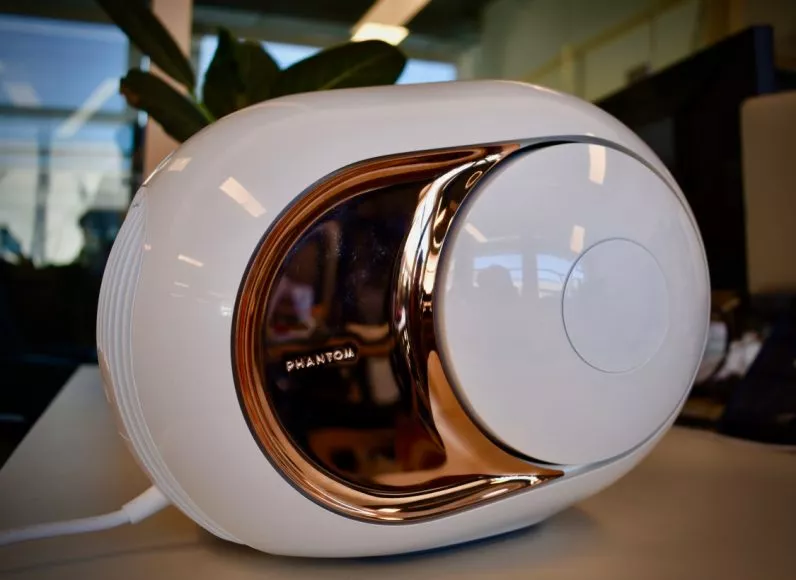
“Phantom, 3 years of R&D, 88 patents filed, 100 million invested... ” – stop. We all know the song, and for good reason: Devialet, a master in the art of marketing, is proud to have created the best wireless speaker of all time.
Let´s forget their marketing announcements and observe the facts: Gold Phantom, 1.58 gallon (6 liters) of volume and 24 lb (11.4 kg) at the withers, promises a power of 4500 Watts with a harmonic distortion amplification rate of 0.0005% and a frequency response sweeping the audible spectrum at +/- 2 dB. On paper, the speaker’s performance seems to defy the laws of physics, but what about it… in reality?
Differences Between Phantom Gold And Phantom Silver: Higher Price And More Watts
If you believe the figures of the French manufacturer Devialet, more than 200,000 phantom loudspeakers are produced per year. Not all of them carry the title Gold, like our test pattern, because besides the royal version there is also the version Silver and a normal Phantom, completely without attribute and title. The difference? The difference between the standard version and the Gold Phantom is 1190 dollars (1100 Euro) and 3300 Watt!
According to the specification, the Gold Phantom has 4,500 watts, measured as a peak.
According to the manufacturer, the Phantom is “the best wireless loudspeaker in the world”. But behind the promises of the marketing department there are no empty shells, but real technological wonders in sound, manufacturing, and design. This comes, of course, at a price.
Improvements From The Silver Version
There are many improvements from the Silver version. One improvement, the frequency response, gets an extension from 14Hz to 27kHz (which is beyond the quality for both human hearing and the frequency for a CD production). Additionally, the company has also improved the digital signal processing (DSP) of the wireless speaker. In terms of the power, the company has also boosted it from the ludicrous 3,000 watts (that comes in the previous models) to an amazing 4,500 watts.
Since the Phantom model is a “gold” product, you have to expect that the said wireless speaker comes with the precious metal finish. The side parts of the Devialet Gold Phantom, called the “gills” are covered with 22-carat rose gold and this is one design that makes it truly high-end.
Better Amplifier
Like the smaller siblings Phantom and the Silver Phantom, Gold uses a so-called hybrid amplifier between Class A and Class D, which Devialet calls ADH. This operates in Class A – the purest but also the least effective way of amplifying a signal – within a normal volume, which in reality only needs a few watts.
But when you need more power is required – as when playing very loudly, the amplifier switches briefly and concisely to the far more efficient Class D. The whole thing is controlled digitally, so that both the sub-woofers play in perfect synergy with each other.
“If it was not for the ADH amplifier, this construction would have been impossible,” said Devialet’s Marketing Manager, Thierry Massoubre, when he delivered the Silver Phantom at that time. “Otherwise one of the drivers would always dominate the other. But here they are absolutely, perfectly controlled, in perfect symmetry.”
The amplifier technology is further refined in the Gold model and is called ADHV2. Where the siblings are quiet, the amplifier in Gold is silent as the grave. Try to put your ear to the tweeter, you will never hear anything.
New Digital Converter
The amplifier is not the only attribute that is new. The entire digital section has been replaced. Whereas the more affordable Phantom models use a DAC from Texas Instruments (PCM1798), Devialet has developed its very own DAC for the Gold Phantom.
This is now an integral component of the ADHV2 amplifier and pushes the digital noise floor from -106 dB and down to -112 dB. It should be noted that there is hardly any microphone or instrument with a noise floor lower than -110 dB, which is around 18-bit resolution. Thus, Gold Phantom will, in theory, be able to reproduce the entire dynamic range on any studio recording.
Construction From Aluminum To Titanium
The missile shape on the cabinet is not a simple coincidence or the display of signature design. A round cabinet prevents upright bass waves. Moreover, it also manages better treble tones that move across the surfaces of a square cabinet, whereupon they are transmitted in all directions as they hit the edges of the cabin. Also known as diffraction, which creates distortion and an inaccurate stereo perspective.
In front of the cabinet sits a coaxial driver with the tweeter mounted in the center of the mid-range driver. The tweeter on the Gold Phantom is made of Titanium, an upgrade from the aluminum dome on the Silver.
Changes In The Price And The Quality
In consideration of the price attached to the Devialet Gold Phantom, the wireless speaker is surely a stand out among others with it being offered at $3000. This may be a high priced wireless speaker but it is also a high-end one which is compared to well-known premium models like the Naim Audio Mu-So as well as the Raumfeld Stereo L.
Compared to the previous version which is the Silver Phantom, the Gold model is $600 more but take note that a lot of noteworthy changes were made. Improvements in the Gold Phantom wireless speaker includes the provision of a smoother mids and treble responses leading to better audio production and performance, an extension of frequency response, in addition to the change in tweeter component from aluminum to a more durable titanium build which will allow for a better treble quality.
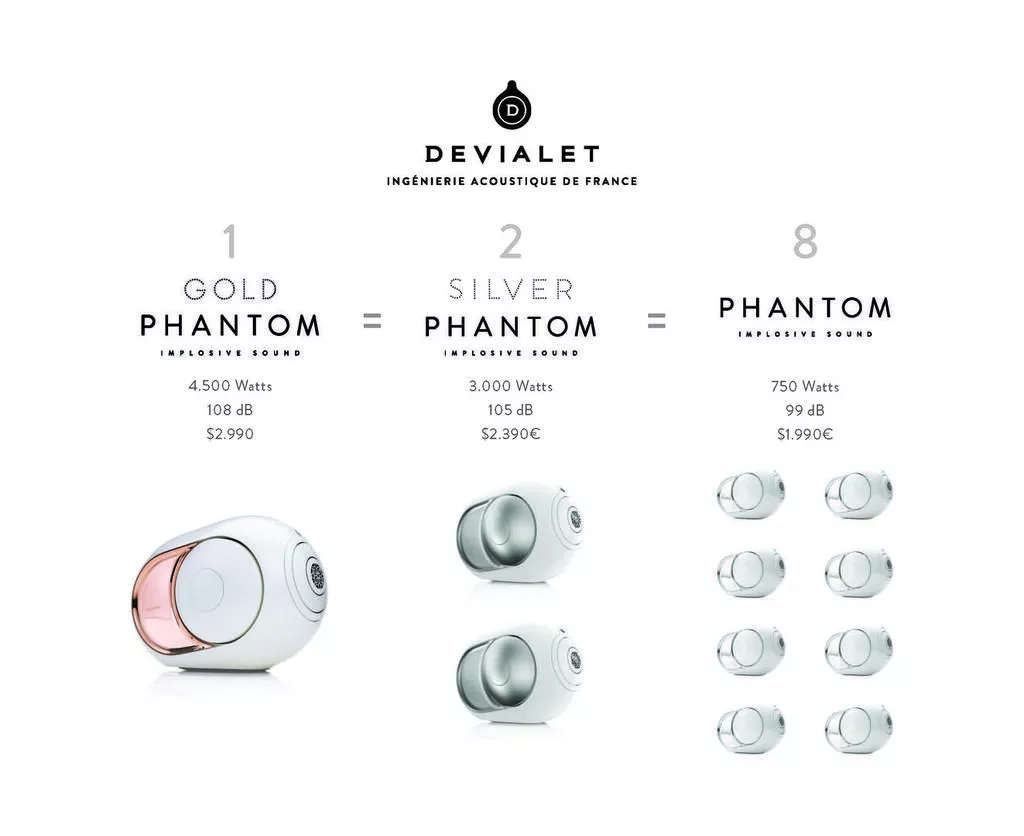
Unboxing the Devialet Phantom: The Contents Of The Box

Once you get over drooling over the package contents of the Phantom, its actually time to take a look at the contents inside. Here, there is not much.
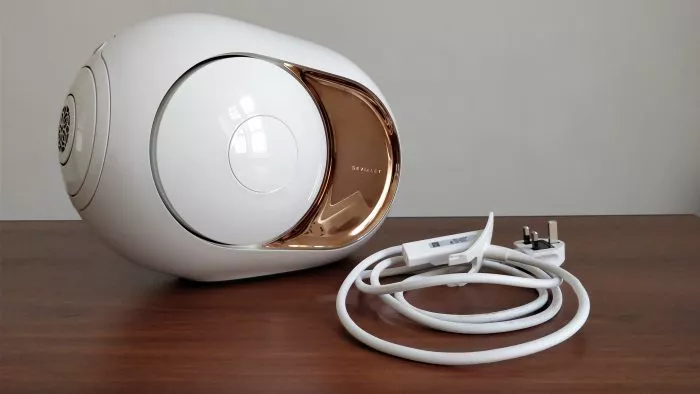
You will find just the bare essentials to get you started. Apart from the speaker itself, you will find a power cable, an instruction manual, and also warranty information and safety precautions to take when using the speaker. Once all of it is unpacked, we finally got around to playing around with the Devialet Phantom. The Devialet Phantom Gold even has its own carrying pouch that resembles a Bowling Ball bag retailing for around $450 upwards.
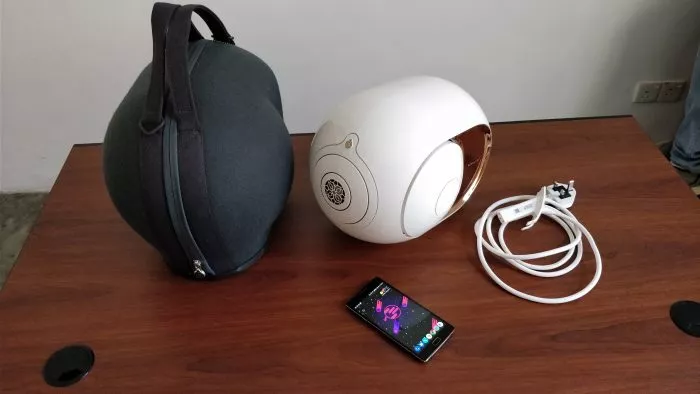
Presentation
As a preamble to this test, we would like to draw the reader’s attention to the fact that Gold Phantom is a wireless speaker which, like Perceval, only needs to be considered as such. No need to compare it to a pair of Genelec or Cabasse, its rivals are to be found on the Zeppelin Air, SoundDock and other Aura.
The rating criteria, therefore, differ from those of a Hi-Fi speaker (the 5-star rating would be denied just because there is no analog input), not to mention those of a monitoring speaker.
We would like to point out that the price does not fall within the rating criteria.
There is no analog input, but could be connected with 720p monitors and dumb TVs through Bluetooth. Depending on the size of your room or home theater, you could simply detach the speakers from the TV, as we showed in our article with the Pioneer Kuro that is an old television with a decent resolution, and connect a Devialet speaker.
Connected briefly with a Samsung OLED monitor, I could test the Devialet in Dolby Digital and in DTS Neo 2.5. Excellent both formats in the Devialet. However, I have not noticed any audible difference. I am sure that DTS could have a better waveform analysis as we discuss in the DTS Neo 2.5 article, but not something you can differentiate in a double-blind or ABX test.
The Phantom Gold nestled seamlessly between the polished wooden paneling of the projection room at home, despite – or precisely because of – its extraordinary appearance, was both an eye-catcher and a sculpture. The white, ellipsoidal case with the gold-plated side surfaces on both long sides can just be called compact, it will fit on every larger – and stable – sideboard. Devialet also offers wall mounts and tripods for the Phantom.
The sides in fine 22 carats rose gold leaf is just as much a sign of his life-affirming style as the lightness of the aluminum woofer and midrange driver cones.
Only the titanium tweeter cone brings a light pinch of hardness into the game, but of course, we do not mean that in terms of sound. As far as the timbre is concerned, the Gold Phantom plays just as flawlessly as its visual appearance suggests. After all, white contains all the colors of the spectrum in their entirety and purity. So it is symbolically the optimal color to summarize what happens acoustically. Because the white of the Phantom – actually a RAL 9016 (Pantone 705) – conveys the charm of a canvas on which colorful pictures are drawn.
Weighing in at around 11.4KG and measuring 10”H x 9.9”W x 13.5”D (253 * 255 * 343mm), the Devialet Phantom actually looks like an abnormally shaped egg of some futuristic creature.
Composed of an all-white sturdy plastic body, the front of the speaker contains the main driver that is protected by a rather ornate grill, adding to the swankiness and aesthetic of the phantom’s design. On either side of the body of the speaker, you will find two woofers that are used for low-frequency effects AKA the “bass”.
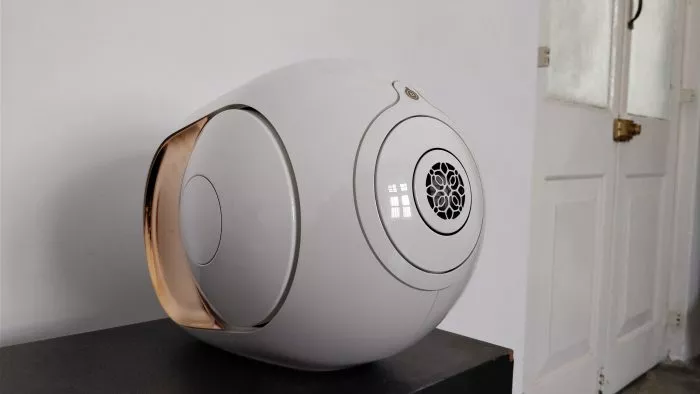
When handling the Devialet Phantom, we actually learned that the best way to carry the speaker is by holding it from the front and back. You should also be very careful to not apply pressure to the front grill or the woofers on the side as they can get damaged if enough pressure is applied.
Taking a step back to look at the speaker itself, it does not really look like a speaker at all. In fact, if we did not know, we would have thought it was something else entirely.
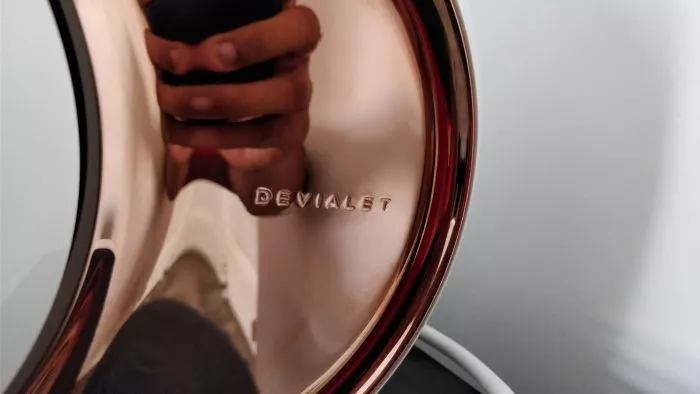
Right behind the two woofers, you will find two removable panels which we dubbed “fingerprint magnets”. Branded with the Devialet logo, the panels do not really serve a purpose, except when you remove it and find a sticker saying you should not open the speaker.
Located at the back of the speaker is the Power button and also the port to connect the power cable. The speaker itself is quite heavy and once set down on a surface will not easily move around or roll about. This will play a significant part in our testing later on below (you will see why).
Ergonomics And Workmanship
Throughout this test, we have constantly noticed how Devialet works with the user’s body to try to create an almost animistic experience. And when we say “to the body”, it is not a figure of style: the hearing is of course solicited, but also the sight and touch.

If, from the front, the speaker mimics a sphere look, in profile its “biophilic” lines are more like a bean. The main body, composed of two symmetrical white ABS shells, has a surprisingly unsightly and unassuming middle junction, unlike the hollow joints that criss-cross the rest of the speaker.

What seems at first glance to be the time capsule of an alien from a science fiction movie, is a pretty ingenious 3-way speaker with a tweeter, midrange, and a pretty spectacular woofer.
The tweeter can still be recognized quite obviously by the flower-shaped perforated grille, but the wider ring around it already represents the midrange driver, one can hardly imagine.
The third way, the bass driver, was placed by the French company, in a double version on the left and right of the sides, so that one can basically speak of a real point source. This eccentric object, which consists of an unbelievable 1 610 components, is manufactured with the highest precision.
In 60 work steps, it passes through over 250 standardized quality assurance checks. More than any other speaker. Any normal person would now say, okay, a high-end manufacturer can do that too. But not every two minutes. Because that is the frequency at which the Phantoms are produced. Of course, this is only possible with the help of robotics and computer control. And just like the product, the laboratories and production lines of the French factories where the Phantom is manufactured look the same. The whole thing is somewhat reminiscent of the series production of vehicles. Any Hollywood movie set from a space strip would be happy about the technology and atmosphere of this company.
The front part, cut into three concentric rings, draws in the center an openwork rosette behind which is a titanium dome tweeter, mounted coaxially with the midrange driver. The logo of the brand in punch overhangs the whole and takes up the pattern of water drop sketched by the outer circle.
The whole is truncated in the lower part so as to slightly tilt the loudspeakers upwards. The sides, carved, accommodate a lacquered pink gold plate, the eponymous shade of the model. The brand name is embossed and the aluminum dome woofer is housed there as an extension of the front sphere.
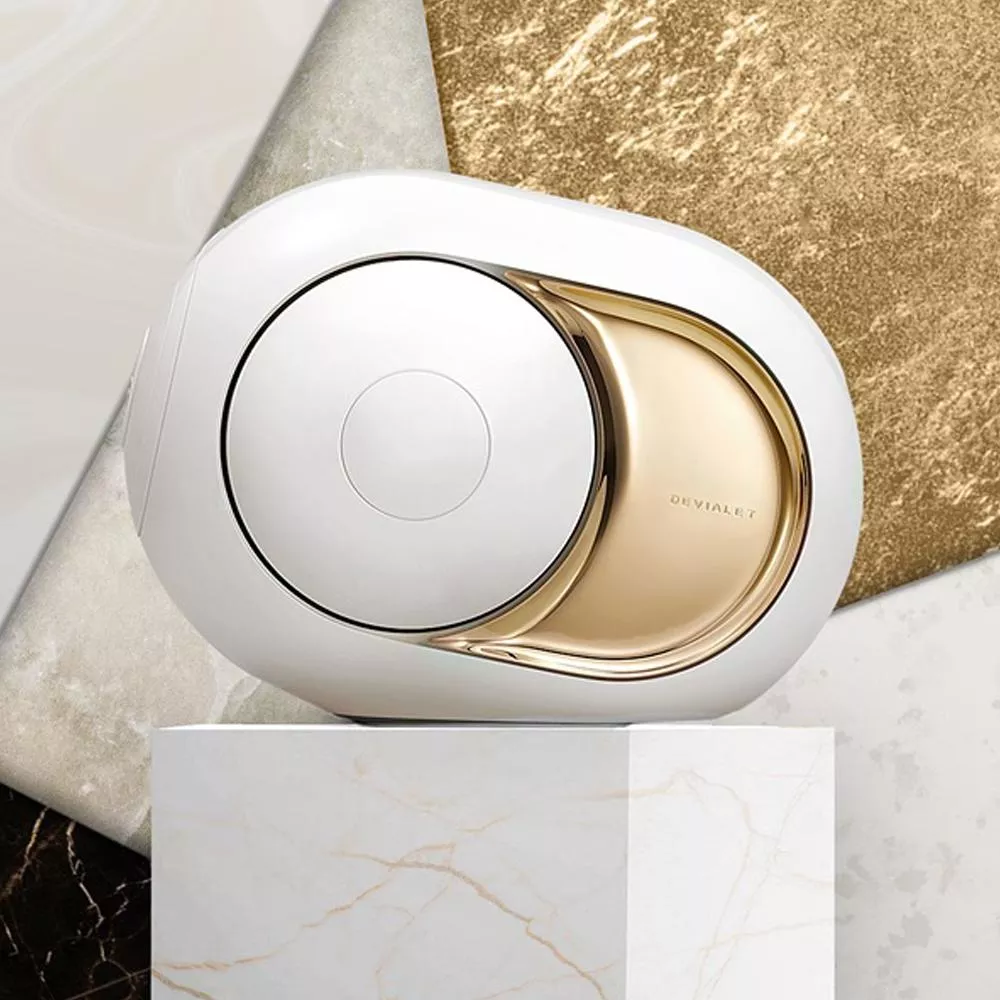
By lifting it the height/weight ratio is surprising: extremely dense, Gold Phantom weighs no less than 24 lb (11.4 kg) for an interior volume of only 1.58 gallons (half a dozen liters).
The speaker has only one button. Among other things, it is used to reset the configuration.
If the plug is in the socket, the box is always ready for use and draws around 20 watts even without music playback. There is no standby mode. A network socket and an optical digital input are available as connections. However, access to both sockets is only possible if the mains plug is pulled, which covers the connections. That’s not very user-friendly!
Only a short manual in miniature format is included in the delivery – for a device in this upscale price range one would be pleased about more information.
A remote control is available separately for just under 150 euros, the Dialog Box for connecting several Phantoms in multi-room operation costs just under 300 euros. It is also equipped with an optical digital input. Devialet also has a tailor-made bag in its range for convenient transport.
The speaker can handle WLAN, Bluetooth, and AirPlay. Stream files with up to 24 bits and 192 kilohertz are supported. Integration into the domestic network is possible via the “Spark” app. Here you have access to your own songs from your smartphone, to Internet radio and to the music services Deezer, Qobuz, Tidal, and Spotify via corresponding paid subscriptions.
Setting up the Devialet Phantom Gold: Bluetooth And WiFi
After we unpacked the device, now we will set it up. I have chosen the easiest way to do it.
The Devialet Phantom Gold speaker can connect to a device via a number of ways. The primary (and easy) way to connect is via Bluetooth. Here, akin to setting up a regular Bluetooth speaker, you would switch on the speaker and search for it in your device’s Bluetooth settings and then pair it up.
Apart from that, the Devialet Phantom can also be connected via WiFi. This requires additional software to be installed on your Laptop, tablet or even smartphone. Called Devialet Spark, the software offers an all in one solution to connect, pair and control the Devialet Phantom Gold speaker.

According to the specifications of the speaker, you can connect up to a total of 40 Devialet Phantom Gold speakers and link them all up. From there, you can literally get each one to play a different song and control each speaker individually. You can even set them up in pairs to have stereo sound from wherever you are. All this, through the Devialet Spark app.
While Bluetooth only allows one speaker to be connected at a time to a device, using Spark, you can connect a pair of speakers via Wi-Fi. The app takes care of setting up speakers and actually took only a few seconds for us to start our playback testing. For starters, we used a laptop and connected via Bluetooth to see how the Devialet Phantom would perform.
The Phantom can be connected via Ethernet or an optical cable, as we briefly said before. The latter is particularly interesting for TVs or external preamplifiers as feeders beyond the network. Both inputs hide extremely skillfully under the power button on the back behind the cover of the power cable. They are honestly so well hidden that we almost missed them for our test.
But even that would not have been tragic because we are testing “the best wireless speaker in the world” as Devialet likes to say, and the integration into the network is – without exaggerating – really excellent.
On the smartphone, we install the Phantom Remote app from Devialet, which finds the loudspeaker abruptly because it sends a Bluetooth signal on factory settings and thus also makes itself publicly known without a network.
Another in-house app also offers a whole range of high-class streaming services, including old friends such as Deezer, Spotify, Qobuz and Tidal, but also classic web radios or the in-house platform “Live on Phantom”, via which Devialet offers live streams from major concert halls. But as soon as you have access and the loudspeaker opens the domestic network periphery all the settings are completed. It is as if the Phantom had waited all his life to play.
A simple power cable is embedded at the rear under the ventilation grille.

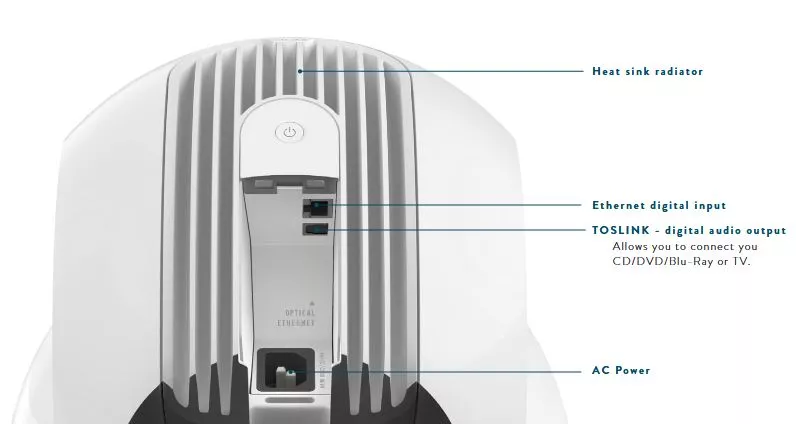
Once connected, the loudspeaker, which is not very cooperative, does not emit the slightest sign of being powered up. Not the slightest light, not the slightest… Ah. Yes, it is. After a few seconds, a flickering chord invades the room, Phantomatic so minor indicating that Gold is on and ready to connect.
Since the Devialet Gold Phantom is a wireless speaker on its own, it can connect in different wireless options of which can be considered both as a Wi-Fi speaker or a Bluetooth speaker. If you prefer streaming it inside your home, you can choose the option of making it as a Wi-Fi speaker which you can control via its dedicated app (for Android, iOS, and Mac), known as the Phantom Shark app. With the app, you can stream music through the Wi-Fi speaker using different streaming services like Spotify, Deezer, Tidal, and Qobuz.
However, if you do not feel connecting the wireless speaker via Wi-Fi, you can use the Devialet Gold Phantom as a Bluetooth speaker. You can pair your devices and play your music with the Bluetooth speaker and still the sound would be pretty decent. If you want to boost the audio from the Wi-Fi speaker or Bluetooth speaker, you can connect two (2) Gold Phantoms together and create a more powerful sound (if you are willing to spend about $6000 for both models).
Connecting the Spark App To Configure The Devialet Speaker
After we connected the device via Bluetooth or WiFi (these are the recommended ways to connect the device), we have to download the Spark application that allows us to configure completely the device.
First of all, you need to download Spark, an essential application for configuring Devialet products. Several options are then available to the user. It is possible to use it “solo” by connecting directly to it via Ethernet or via Wi-Fi connection.
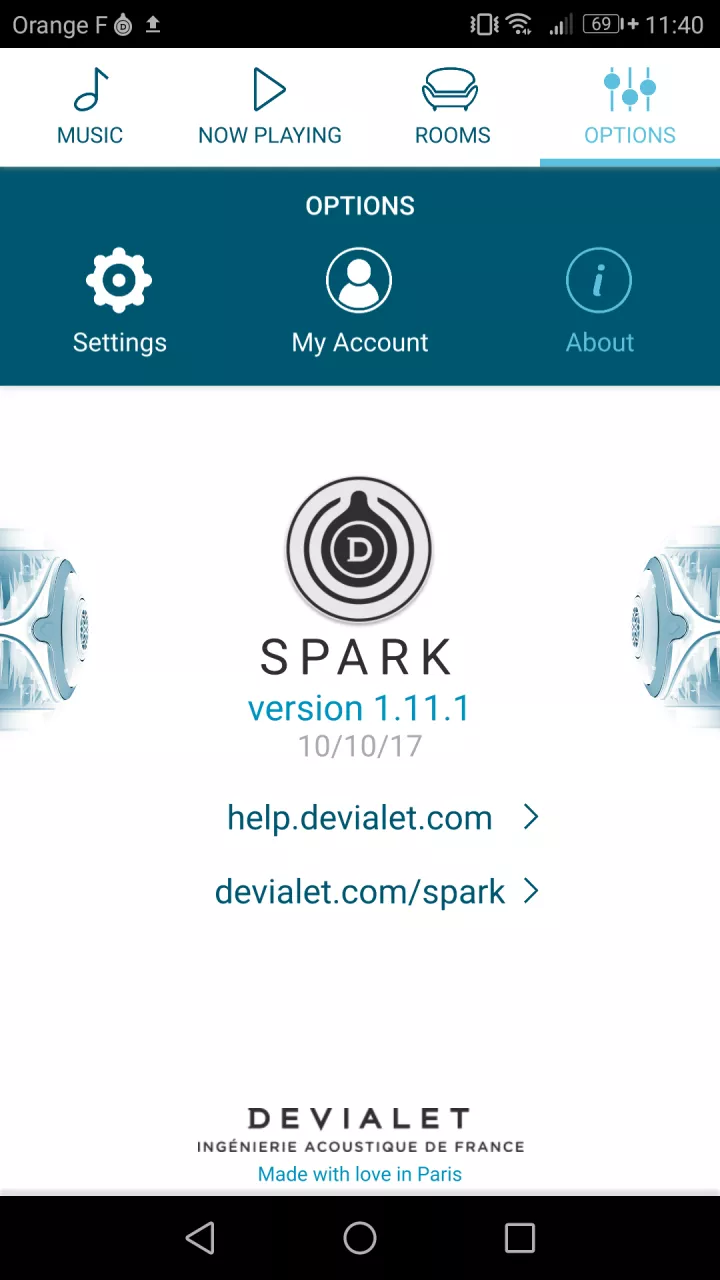

To do this, you have to press the button on the back of the speaker once, to which Phantom reacts by emitting a distinctive “click” while shaking its lateral gills. All you have to do is connect from your device to the PhantomSetup network, then let yourself be guided by the application.


The application first recognizes Dialog, after which you must place your hand on the back of each speaker for it to be recognized. The recognition is systematically validated by the expiration of the speakers, as always accompanied by the excitement of the woofers.
The connection technology is extremely basic: Gold Phantom is AirPlay and Bluetooth compatible and has a Toslink input on board, attached to an RJ-45 port, carefully hidden in the hollow of the power supply base.
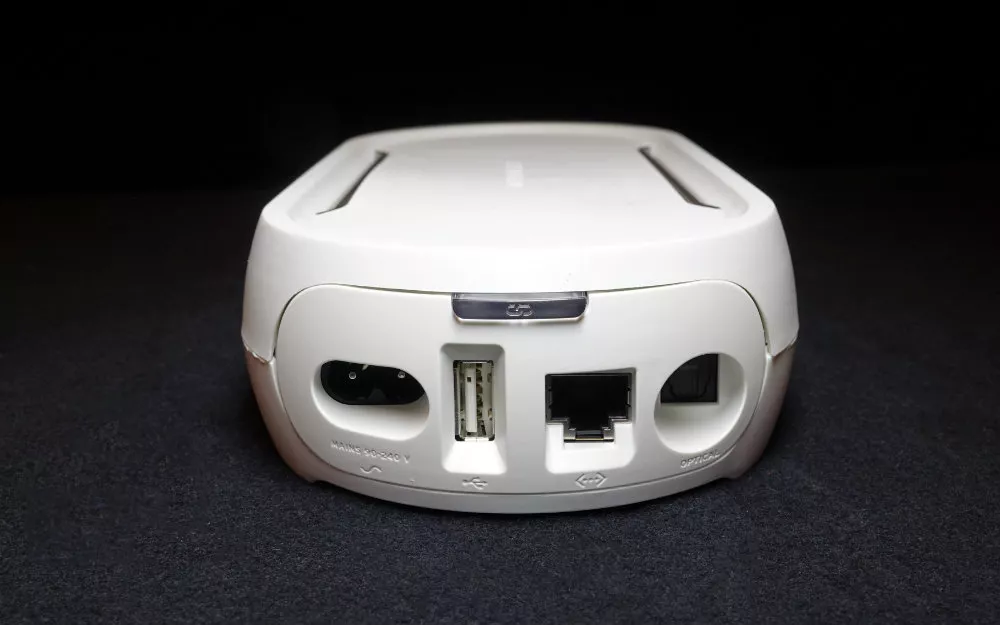
Dialog has strictly identical connectivity. HDMI or RCA point… or even an analog input in mini-jack. The same applies to the remote control, which is only used to adjust the volume… which is already done from the application without which the speakers cannot be controlled. In short, no need to say more: it is useless.
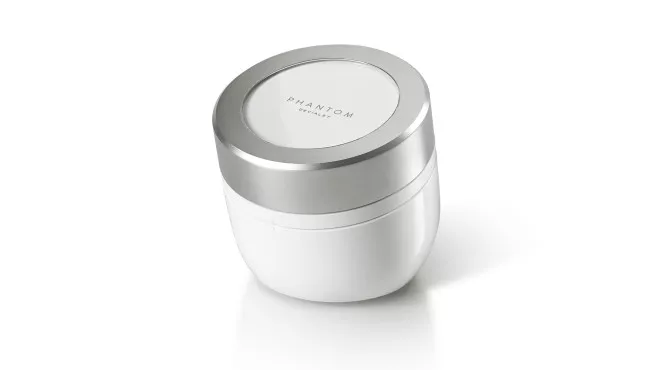
No other connection or setup is needed. You do not need to connect an amplifier to it.
User Experience
Streaming services include Deezer, Qobuz, Tidal, a comprehensive list of radio stations (organized by country and music genres) and, as always, Spotify Connect. To take advantage of the latter, you must exit the application, go to the appropriate application, then select the name of the multiroom group created in “Available devices”).



Now Playing indicates the playlist of the tracks listened to / to come, a list that is created by selecting any file (music, podcast), scanning to the left and choosing “Add to playlist”.
The speaker groups to which these playlists are assigned are visible in the Rooms tab. Spark has the ability to read files on the Cloud, a feature that Apple has blocked to date (above left: plain text podcasts downloaded; grayed out tracks on the Cloud, not yet readable).
For the purposes of this test, we have paired two Gold Phantom – but please note, dear Rockefellers, that Dialog can manage up to 24 speakers simultaneously and thus create as many multi-monophonic, stereophonic or multi-channel groups as possible.
Let’s look for a moment at the latter term, used by Devialet: since the system is currently unable to read a multi-channel stream, it is, in fact, possible to create what could be called “multi stereo”, i. e. assign several speakers to the left channel and/or the right channel. Read more about this here in our related article.
The creation of groups is just as fluid as the configuration of the speakers themselves: the speaker concerned emits a crystalline sound when you grab the corresponding icon on the application, which you then simply drag to the chosen position (above, left stereo, right stereo or mono) to assign it the appropriate channel. Unfortunately, these groups cannot be modified “live“: if you want to switch from a pair of stereo speakers to a double mono (to sound two different rooms, for example), you will have to reset the speakers, then configure them again. Future updates promise to solve this problem as well as the problem of not supporting multi-channel, which is something to follow.
Finally, the Options tab gives access to information about the application and the user’s account, but also to the settings. Here you can enable/disable each source, select the quality of the streamed files (for example, for Qobuz: Hi-Res, Flac or MP3) and configure each device (speaker name, optical input and/or Bluetooth activation, UPnP compatibility beta test for Dialog, source selection, connection indication).
Testing Audio Of The Devialet
Taking a look at the technologies that make up the Devialet Phantom, you would probably need another book to note them all down. For example, the speaker makes use of a proprietary converter embedded in Devialet’s Analogue Digital Hybrid (ADH) technology. Referred to as ADHV2, it combines Class A and Class D amplification, to give the speaker the best of both worlds whilst also minimizing the shortcomings of both classes.
For the performance, we compared the Gold Phantom with the previous models like the Silver Phantom. Testing it with few sounds, we would say that the new version is absolutely an improved Phantom wireless speaker. The old version lacked vibrancy with the sound quality while the Gold Phantom has achieved to sound open and dynamic. The new model has managed to deliver a powerful treble and bass thus filling the room with loud sound with excellent clarity and balance.
The Tweeter of the Devialet Phantom is a titanium dome and has the ability to playback audio of up to 24-bit/192kHz. In terms of frequency, the Devialet Phantom will go down all the way to 14Hz (you will not really hear it, but you will feel it). And goes up to 27kHz at the top end. If dogs in the area start acting strangely, you will know why.
While all our testing was done via Bluetooth, where the Devialet Phantom really shines is when it is connected via Wi-Fi. Certified for Wi-Fi for dual-band (a/b/g/n) at 2.4 and 5GHz, not only does the audio quality improve significantly, but it also gets the ability to work with multiple Phantom Gold speakers. In addition, the Devialet Phantom Gold is one of the few speakers in the market that are certified for lossless wireless audio. This essentially means that when playing audio over Wi-Fi, there is absolutely no drop is the audio quality (unlike Bluetooth).
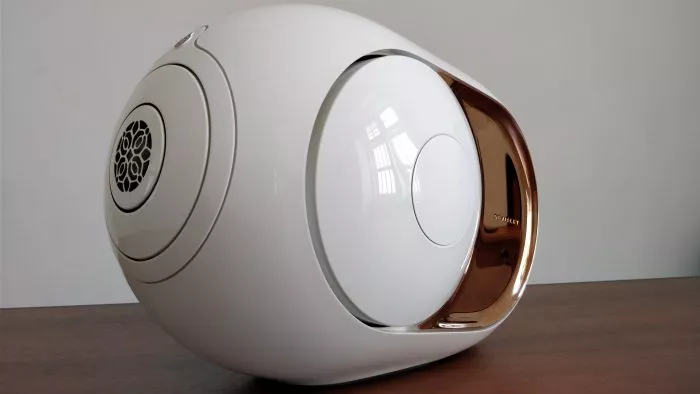
Apart from that, the Devialet Phantom Gold speaker is also able to connect to streaming services such as Spotify, Deezer, Tidal and even Web Radio. Using the RJ-45 port located at the back of the speaker, you can also connect the Devialet Phantom Gold to your router and then configure it from that as well.
The Results Of the Test
From the beginning, the originality of the French project lay in the machine’s dizzying promise of power, namely 4500 Watts, generating a pressure of 108 dB at 1 m – the equivalent of a modest airplane at about a hundred meters, or a jackhammer.
By sending a signal at -15 dB FS (optically, of course) and only 55/100 of the internal amplification, the loudspeakers already reach the pressure level traditionally required for our measurements, namely 85 dB SPL at 1 m.
From 150 Hz onwards, the harmonic distortion rate drops below 1%, a threshold that will no longer exceed 20 kHz. Below, the peak at 80 Hz, in particular, is clearly detectable to the ear. We then decide to take our test protocol a little further, by measuring the harmonic distortion rate at 94 dB SPL (8 times more power than at 85 dB SPL), at 97 (16 times), then at 100.
It even seems that the higher the level, the more comfortable the speaker is. The famous 108 dB SPL was reached… and exceeded.
It is no exaggeration to say that Gold Phantom is the most powerful of the speakers that have gone through our sound testing, with a proportionally lower distortion rate (because if not, yes, you could name the Sony GTK-XB7 that we also reviewed). Bet won for Devialet on this side so… from 150 Hz.
The overall rendering is colored, and the spectrum is cut extremely clearly. The basses, powerful, dynamic, punchy, benefit from a great reactivity, both on the attack side and on the release of notes. Despite an optimizable distortion rate, their accuracy protects the rest of the spectrum from potential overflow risks.
The low-midrange drivers are both flattered and mastered, which not only provides a solid frequency base for the mix, but also a great feeling of sound immersion. Be careful though, the hump around 200 Hz may not be to everyone’s liking: the emphasis is not subtle, and may on some pieces create a coloration that will not go unnoticed. The peak observed around 60 Hz, on the other hand, inherent in our acoustic measurement room (standing wave at 61 Hz), is in no way correlated to the performance of the speaker itself.
A little higher up, we are at the heart of instrumental tessitura, especially that of voices. The velocity of the membrane dedicated to this frequency band transcribes the timbre of these instruments with great clarity and presence. The high-pitched midrange, which reads the first harmonics, is recessed, which contributes to this characteristic sound signature.
Finally, the high frequencies, which are very present, enjoy excellent definition. The most obvious beneficiaries are the plucked strings and percussion (folk guitar, harpsichord, pizzicato playing, triangle…) which shine through their presence.
However, the big winner, much more subtle, but oh so important, is the reverberation: the spaces are therefore transcribed with an astonishing level of realism. The reverse side of the piece is a sometimes overly marked representation of this part of the spectrum, which can be chemical on some instruments – especially cymbals. The rendering is brilliant, sparkling, sometimes slightly drooping, but never sibilant (the distortion being extremely well contained on this part of the spectrum).
It should be noted that with only one Phantom, the sound is monophonic: the scene does not lead to a large one, it is undeniable, but at least the summation of the two channels is well thought out and does not generate any phase problems.
The stereo transition is a nice surprise: the stage unfolds with breadth and precision, the ghost center and extremes showing striking stability and presence. The rest, on the other hand (between the center, pan 0, and the extremes, pan 100% left or right) is more blurry and would have deserved a better definition.
Let’s finish with the measurement of latency, which unfortunately excludes any use other than musical unless we can delay the image by a fifth of a second: the impulse response in optics betrays a 190-millisecond delay, largely perceptible during film viewing.
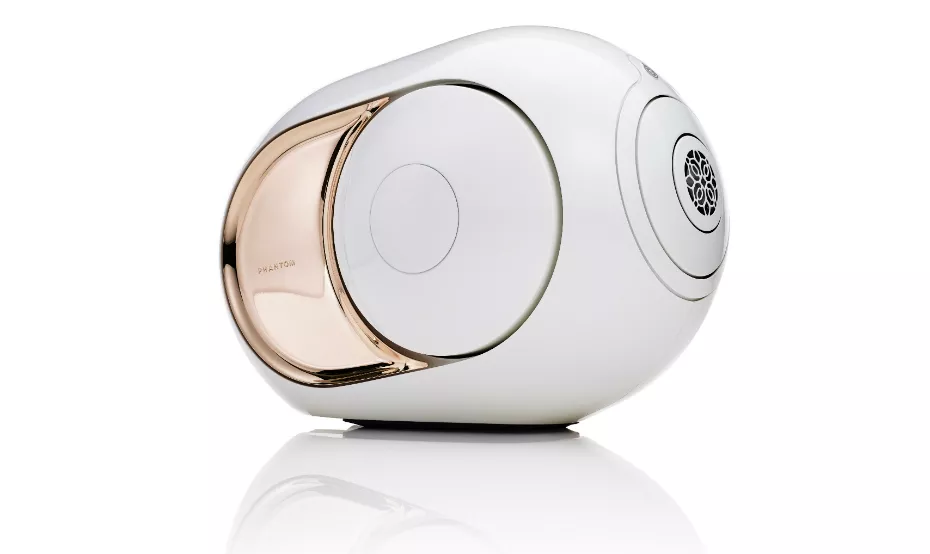 Gold Phantom is the most extreme Devialet speaker ever. Photo: Devialet
Gold Phantom is the most extreme Devialet speaker ever. Photo: Devialet

Conclusions: Is the Devialet Gold Worth It?
Through an interactive experience, Devialet clearly does everything possible to create a powerful affect link between the Gold Phantom and the user. Speaking of power, the promise is kept: the speaker simply delivers the best compactness to power ratio that the walls of our sound lab have ever seen. However, it should be noted that the sound signature is not neutral and that the ergonomic exclusion of certain uses (absence of analog input, high Bluetooth latency) may cool more than one.
Is it worth it? Well, the answer to that is quite personal, literally. If you have the cash to splash and you want something funky in your high rise apartment, then the Devialet Phantom Gold will appeal to your inner swankiness.
It can be a great conversation starter, an ice breaker or even used for bragging rights to say that “…..this is not just a speaker but a whole lot more…..”. The Devialet Phantom would also be handy if you find yourself at a loss for space or want a wire-free entertainment system that is also portable, then the Devialet Phantom can be a go-to option.
The Devialet Gold Phantom is now available in the market. It is neither a typical Wi-Fi speaker nor a Bluetooth speaker but is considered as a very high-end/premium wireless speaker that is uniquely beautiful in terms of design and is undeniably amazing in terms of performance. As impressive as it is to desire one, you have to spend a higher price for the model, but if you do not worry about spending $3000 for one then you are making a smart decision for yourself. So, check out Devialet Gold Phantom now.

But What is “Devialet”?
For the record, the brand name refers to Guillaume Vialet, engineer and sub-inspector of civil engineering and pavements, Diderot’s friend and co-author of some articles in the Encyclopedia. Devialet says it is “deeply inspired by the Philosophy of Enlightenment” and “aspires to scientific progress that makes mankind better” – the name of the company that owns the “Ingénierie Acoustique de France” extension, which voluntarily remains in Molière’s language, even in other countries. A true tribute or marketing smoke, the etymological anecdote remains interesting.
Further Readings
We have some other interesting articles for you to read, we have selected our top articles below, and tried to keep this list short.
We have a technical vademecum where we discuss industry terminology and how it can be useful for you. Selected examples are the definition of PCM audio, then comes the comparison between PCM and Bitstream, the comparison between DTS Neo 2.5 and Dolby Digital, and the process to match amplifiers to speakers.
Also, we have reviewed some interesting DAC: The Elgar Plus from dCS, and the Schiit stack. where the Modi 3 behaves as an entry-level DAC.
In our reviews of AV receivers, we can recommend you to read some of our favorites, the ones that we liked the most, and trying to make the list short, we have the Denon AVR-X2500H, the Onkyo TX-NR686. We also have reviewed completely the Denon 8K receivers where we have studied the 8K Denon AVR-X2700H, the Denon AVC-X6700H, the AVC-X4700H, and the AVC-X3700H.
If you are into amplifiers, my favorite is the McIntosh MA9000, and that is why I would like to recommend you to read that review. My second favorite amplifier is the Mark Levinson 5805.
Regarding speakers, we have reviewed tiny bookshelf-speaker devices to large towers. My favorites were: the Devialet Gold, the Devialet Silver, the ProAc Response DT8, the Bowers and Wilkins 805 D3,
We do not review many headphones, but if you want a Sennheiser headphone for less than 100 dollars, we have this Sennheiser HD595 review.
We have some TV and monitor reviews and here we recommend the Samsung NU8000 (for gamers!) and my favorite is the review of the classical Pioneer Kuro.
Our home theater aficionados want to know everything about video definitions and configurations. So we studied 720p, how to scale it to 1080p the right way, and compared 1080p with 1440p and demonstrated why 1440p is not always better. Likewise, we had the urge to compare 1440k with 4K and try to find out how much are we gaining with the change.

I am Bob. I work as an audio engineer and audio technician. I work in mastering and arranging bridges in existing songs and the arrangement and orchestration of the chorus. In Planet HiFi I test gear for a couple of days and write a review. I also write about AV topics, amplifiers, speakers, and headphones.

